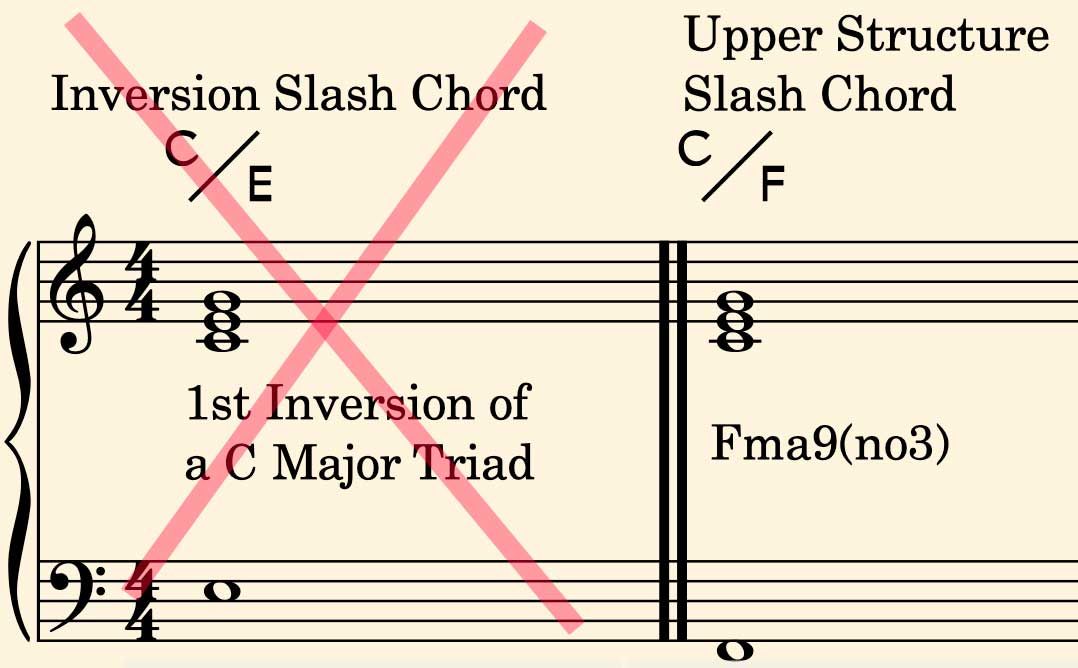About this article
In this article, I will explain what Upper Structure Chords are and how to use them effectively in your playing.
Examples for how upper structure chords are used
The video presents four brief examples of Upper Structure Chords used in various jazz and pop music genres.
As you can see in the video, those Upper Structure Chords are great devices for creating beautiful voicings with ease.
By the way, those Upper Structure Chords are not only helpful to our keyboard playing. Skilled music arrangers and improvisers use them as well.
What is an Upper Structure Chord?
An Upper Structure Chord (USC) is a chord (often just a major, minor, diminished, or augmented triad) that includes chordal extensions or tensions (for example 9, 11, 13).
Why do we use Upper Structure Chords (USCs)
USCs help us think, read, write, and perform chords (harmony) more easily. Additionally, they are often the best choice for writing certain chords that can only be expressed using complex regular chord symbols.
The two different Types of Upper Structure Chords
AAn USC can be placed above a single bass note, forming a Slash Chord, or above another chord, which is called a Lower Structure Chord (LSC), creating a Poly Chord.
USC - Type 1: Upper Structure Slash Chord
An Upper Structure Slash Chord (USC) is created when a chord is placed above a single bass note that is not part of the chord. For example, C/F represents a C major triad played over the bass note F. In this case, F is not a part of the C major triad!

When the bass note is a pitch that is also found in the USC, the result is simply an Inversion. For example, C/E is the slash chord for the 1st inversion of a C major triad.
IMPORTANT: We may call C/E a Slash Chord, but calling it an Upper Structure Slash Chord would be wrong. (See above example.)
USC - Type 2: Poly Chord
A USC (Upper Structure Chord) placed above another chord, known as the LSC (Lower Structure Chord), is referred to as a Poly Chord. The USC and the LSC are written on top of one another and separated by a horizontal line, as illustrated below.

Here is a short video that shows you how Oscar Peterson used Upper Structure Chords in his improvisations. A MUST SEE!
The following video is yet an other example for how Upper Structure Chords can be useful specifically in combination with broken chord runs and arpeggios.
The upper structure example starts at 4:20.
Tip: You might get a lot of interesting ideas out of watching the entire video, especially when you like to improvise with broken chords and arpeggios made from triads!
Poly Chords for Extended Dominant Seventh Chords
One of the most common application of the USC idea is for creating voicings of Dominant Seventh Chords.
Below is a table that shows Poly Chords for a C7 chord with major and minor Upper Structure Triads based on different scale degrees.

Tip: By memorizing the distance between the root notes of the LSC (C7) and USC and the triad's quality for each of those chords we can make playing complex dominant seventh chords in any key much easier.
Below is the same table of Dominant Seventh Chords shown above, only this time written with Nashville Chord Symbols, which shows the chord symbols and poly chords key independent.

Example for how to use this table
Let's say you want to play F13(311). Looking at the above table, we find this chord in bar 2.
The poly chord gives us the following instructions:
1. Find the root note of the Upper Structure Chord by going up a whole step from the root note of the F13#11) chord. Going up a whole step from F is G.
2. Build a major triad based on G
3. Play a F7 shall voicing (F, A, Eb) in the left hand as the Lower Structure Chord (LSC) and play a G major triad (G, B, D) on top with your right hand. Note: It doesn't matter in which position (inversion) you plat the USC!
Note: The position (inversion) of the USC does not matter; it can be in root position or any inversion. It simply depends on which chordal note you want at the top of your voicing.
